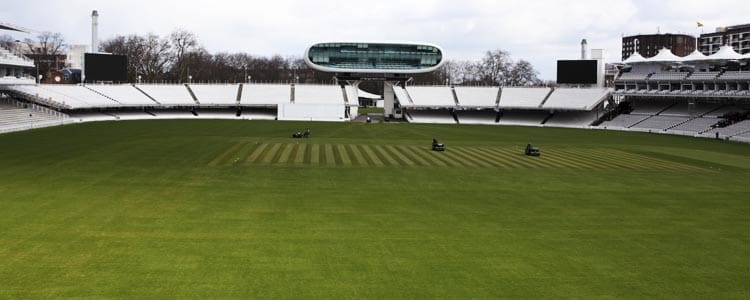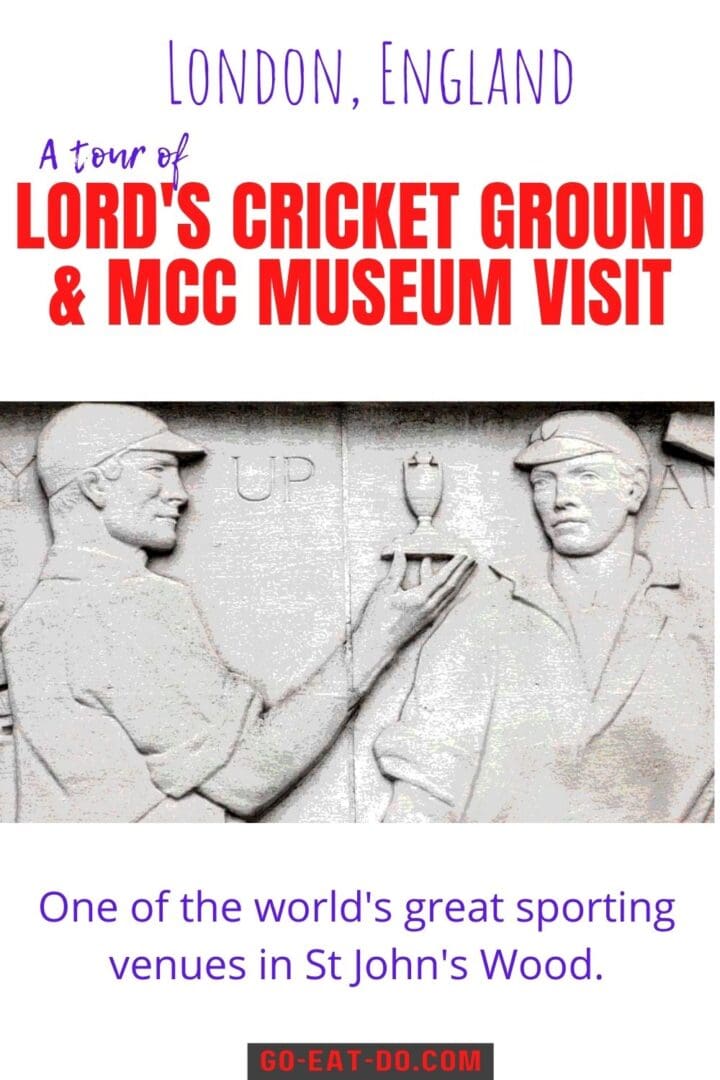Stuart Forster heads to London to visit the MCC Museum and for a Lord’s Cricket Ground tour, and learns that historic sporting venue is not just associated with cricket.
Disclosure: Some of the links below and banners are affiliate links, meaning, at no additional cost to you, I will earn a commission if you click through and make a purchase.
Lord’s Cricket Ground, in the St John’s Wood district of London, is one of the world’s greatest sporting venues. It is widely regarded as the home of cricket yet it also has one of England’s oldest real tennis courts. The laws of lawn tennis were standardised at Lord’s in the 1870s.
For fans of cricket, nothing beats attending a Test match at the famous ground, which is now more than 200 years old. However, if you can’t attend a fixture, it’s still possible to visit the MCC Museum and join a guided tour of Lord’s Cricket Ground.
Tour of Lord’s Cricket Ground
I joined a tour of the famous old ground, which Thomas Lord acquired for the Marylebone Cricket Club (MCC), back in 1814.
If you’ve got 100 minutes to spare and are keen on sporting history it’s well worth taking a tour. Guided tours run most days, as long as the ground is not being made ready for or hosting a major match.
MCC Museum
In the museum, I saw the original Ashes urn.
The England and Australia cricket teams compete for The Ashes. It is the basis of one of the world’s great sporting rivalries.
Even if the Aussies win an Ashes series, the original 10-centimetre tall urn remains on display in London. England fans inevitably hope that the men in baggy green caps don’t even get their hands on a replica version.
If you enjoy the history of this sport then you’ll find it rewarding to browse the exhibits of the MCC Museum. It hosts artefacts dating from the earliest days of cricket, including items from around the world.
In addition to signed bats, oil paintings, trophies and blazers – the kind of thing you’d expect to see – there are some unusual items. These include the stuffed sparrow, which on 3 July 1936 made the fatal error of flying in front of a delivery from Cambridge University’s Jehangir Khan.
Entry to the MCC Museum is only permitted in conjunction with a tour of Lord’s Cricket Ground or with a valid ticket for a day’s play.
Long Room at Lord’s Cricket Ground
In the Long Room Bar, I enjoyed a cup of coffee while viewing portraits of cricketers such as Ian Botham and Mike Atherton. More oil paintings are displayed in the Long Room, depicting some of the great names associated with the ground and the history of cricket.
Perhaps the most eye-catching is Lewis Cage: The Young Cricketer, a painting dating from 1768 by Sir Francis Cotes. Antony Amos, Lord’s Tours and Museum Manager, saw my interest and explained, “it’s showing you the dress, two stumps and an old cricket bat, giving you an idea of the development of the game”.
Lord’s dressing rooms
We then took a look in the dressing rooms and spent time reading the honours boards. New names are added if there are notable performances in Test matches.
One of the highlights had to be stepping out through the dressing room doors and onto the pavilion’s balcony. For a few moments, I felt a tingle of excitement as I imagined how it might feel to be padded up and ready to take to the field during a Test.
I learned that the Nursery End is not named because of the cricket academy that nurtures new talent but because, long ago, it was the site of a garden nursery.

J.P. Morgan Media Centre
The Nursery End is the home of the J.P. Morgan Media Centre, where up to 120 journalists work during major matches.
Inside the media centre Irving, one of the guides who lead visitors around Lord’s, asked “why do you think these windows are sloping inwards?”
A fellow visitor guessed that it prevents rain from leaving streaks on the glass. The correct answer is that the design helps ensure batsmen are never dazzled by reflections on the glass on sunny days.
Lord’s Cricket Ground tour
Irving has guided tours at Lord’s since 1990 and jokes that only the famous Father Time weather vane on the Grand Stand has been in the ground longer. The figure on up the stand’s roof represents the Grim Reaper in the guise of an umpire, taking off the bales.
A reminder, perhaps, that we should make the most of the time we have remaining on this planet and strive to enjoy our innings.
After touring the ground I entered the Lord’s Tavern to experience another of England’s great traditions; a lunch of fish and chips accompanied by a pint of hand-pulled ale.
Map of Lord’s Cricket Ground
The map of Lord’s below shows the cricket ground’s location in London’s St John’s Wood district. Zoom into or out of the map for more details or view the ground’s location:
Getting to Lord’s Cricket Ground
Marylebone station is approximately 10 minutes’ walk from Lord’s.
Check up-to-date fare and route information on how to get to Lord’s Cricket Ground using public transport on the Transport for London website.
The nearest Underground station to Lord’s cricket ground is St John’s Wood, on the Jubilee line, approximately five minutes walk away. The Baker Street, Edgware Road, Marylebone and Warwick Avenue Tube stations are also within walking distance. Signs point to the ground from Baker Street station (on the Jubilee, Bakerloo, Metropolitan plus Circle and Hammersmith and City lines).
Buses 13 and 113 run along Wellington Road on the east side of Lord’s. Over on the west side, buses 139 and 189 run along Grove End Road.
Parking near Lord’s Cricket Ground is available at Kingsmill Terrace car park (NW8 6AA).
Hotels near Lord’s Cricket Ground
Search and book accommodation near Lord’s Cricket Ground and elsewhere in London via HRS:
Books about The Ashes and Lord’s
Keen to know more about The Ashes and the history of Lord’s Cricket Ground? You can buy the following books from Amazon by clicking on the links or cover photos:
Official MCC Story of the Ashes by Bernard Whimpress:





Further information
Visit the Lord’s – The Home of Cricket website for more about tours of the ground.
See the Visit London and Visit Britain websites for more information about things to do in London.
Stuart Forster, the author of this post, has previously written and photographed for Wisden. He is a travel writer from northeast England.
Thank you for visiting Go Eat Do and reading this post about Lord’s Cricket Ground and MCC Museum, London. Planning a trip to London and appreciate visiting sporting venues? You may also enjoy visiting the Queen Elizabeth Olympic Park in east London.
‘Like’ the Go Eat Do Facebook page to see more photos and content.
If you enjoyed this post why not sign up for the free Go Eat Do newsletter? It’s a hassle-free way of getting links to posts on a monthly basis.
A version of this post was originally posted on Go Eat Do on 13 July 2013.



